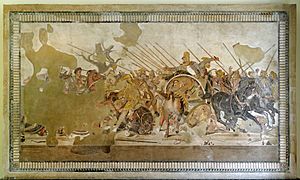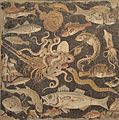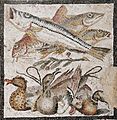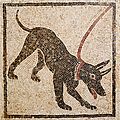National Archaeological Museum, Naples facts for kids
| Museo Archeologico Nazionale di Napoli | |
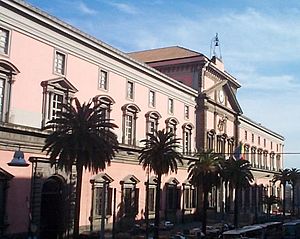
Façade of the museum
|
|
| Established | 1777 |
|---|---|
| Location | Piazza Museo 19, Naples, Italy |
| Type | archaeology |
| Collections | Romans, Greeks, Egyptians |
| Visitors | 500.000 (2017) |
| Public transit access | Fermata Museo (Metropolitana linea 1) Fermata Piazza Cavour (Metropolitana linea 2) |
The National Archaeological Museum of Naples (Italian: Museo Archeologico Nazionale di Napoli, abbr. MANN) is an important Italian archaeological museum, particularly for ancient Roman remains. Its collection includes works from Greek, Roman and Renaissance times, and especially Roman artifacts from the nearby Pompeii, Stabiae and Herculaneum sites. From 1816 to 1861, it was known as Real Museo Borbonico ("the Royal Bourbon Museum").
Contents
Building
The building was built as a cavalry barracks in 1585. From 1616 to 1777 it was the seat of the University of Naples. During the 19th century, after it became a museum, it suffered many changes to the main structure.
Collections
The museum hosts extensive collections of Greek and Roman antiquities. Their core is from the Farnese Collection, which includes a collection of engraved gems (including the Farnese Cup, a Ptolemaic bowl made of sardonyx agate and the most famous piece in the "Treasure of the Magnificent", and is founded upon gems collected by Cosimo de' Medici and Lorenzo il Magnifico in the 15th century) and the Farnese Marbles. Among the notable works found in the museum are the Menologium Rusticum and the Herculaneum papyri, carbonized by the eruption of Mount Vesuvius, found after 1752 in Villa of the Papyri.
Marbles
The greater part of the museum's classical sculpture collection largely comes from the Farnese Marbles, important since they include Roman copies of classical Greek sculpture, which are in many cases the only surviving indications of what the lost works by ancient Greek sculptors such as Calamis, Kritios and Nesiotes looked like. Many of these works, especially the larger ones, have been moved to the Museo di Capodimonte for display in recent years.
- The Farnese Hercules, which fixed the image of Hercules in the European imagination.
- The Farnese Atlas is the oldest extant depiction of Atlas from Greek mythology, and the oldest view of the Western constellations, possibly based upon the star catalog of Hipparchus
- The Farnese Bull, widely considered the largest single sculpture ever recovered from antiquity.
- The group Harmodius and Aristogeiton, a Roman copy of a bronze work that once stood in the Agora of Athens
- The Aphrodite Kallipygos
- The Farnese Artemis, again a Roman copy of a Greek original
- a collection of busts of Roman emperors
- another set of Roman sculptures (again mainly copies of Greek work) that (like the Hercules) once stood in the Baths of Caracalla in Rome.
Bronzes from the Villa of the Papyri
A major collection of ancient Roman bronzes from the Villa of the Papyri is housed at the museum. These include the Seated Hermes, a sprawling Drunken Satyr, a bust of Thespis, another variously identified as Seneca or Hesiod, and a pair of exceptionally lively runners.
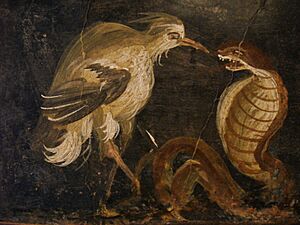
Mosaics
The museum's Mosaic Collection includes a number of important mosaics recovered from the ruins of Pompeii and the other Vesuvian cities. This includes the Alexander Mosaic, dating from c. 100 BC, originally from the House of the Faun in Pompeii. It depicts a battle between the armies of Alexander the Great and Darius III of Persia. Another mosaic found is that of the gladiatorial fighter depicted in a mosaic found from the Villa of the Figured Capitals in Pompeii.
Egyptian Collection
With 2,500 objects, the museum has one of the largest collection of Egyptian artifacts in Italy, smaller only than those in Turin, Florence and Bologna. It is made up primarily of works from two private collections, assembled by Cardinal Stefano Borgia in the second half of the 18th century, and Picchianti in the first years of the 19th. Since the recent rearrangement of the galleries, these two cores of the collection have been exhibited separately, while other items are on display in the connecting room, including Egyptian and "pseudo-Egyptian" artefacts from Pompeii and other Campanian sites. The collection provides an important record of Egyptian civilization from the Old Kingdom (2700-2200 B.C.) up to the Ptolemaic-Roman era.
Gallery
-
The Menologium Rusticum Colotianum, an ancient Roman almanac
See also
 In Spanish: Museo Arqueológico Nacional de Nápoles para niños
In Spanish: Museo Arqueológico Nacional de Nápoles para niños
- List of largest art museums


